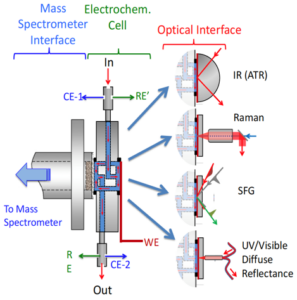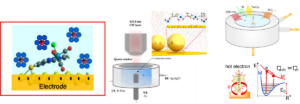MURI: Molecular Level Studies of Solid-Liquid Interfaces in Electrochemical Processes; AFOSR
Despite its fundamental and technological importance, a molecular-level mechanistic understanding of the factors that drive efficient multi-electron inner-sphere electrocatalysis remains elusive, impeding systematic progress toward innovative and more efficient energy conversion technologies. Addressing this longstanding grand challenge requires multi-faceted methodologies that go beyond classical current-voltage measurements and combine operando spectroscopic probes and atomistic simulations to develop multiscale models of critical interfacial processes. This MURI program is a multidisciplinary effort aimed at developing a molecular-level understanding of the fundamental processes that drive complex electrochemical reactions. The research effort in the Lian group is focused on developing advanced in situ surface selective electrochemical vibrational spectroscopy tools and applying these tools to study molecular structure and dynamics at the electrode/liquid interfaces. Specifically, we are developing time-resolved vibrational sum frequency generation spectroscopy and surface enhanced Raman spectroscopy as new techniques for probing interfacial dynamics.
Current projects:
- The effect of electrode induction of adsorbed catalysts
- Light-driven electrochemistry: quantifying hot carrier and thermal effects
- Time-resolved SFG study of hot carrier induced vibrational dynamics



